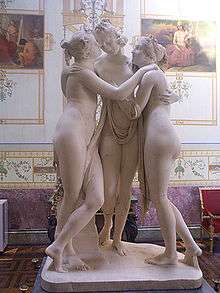Aglaea

Aglaea (/əˈɡliːə/) or Aglaïa (/əˈɡlaɪə/; Greek: Ἀγλαΐα "splendor, brilliant, shining one") is the name of several figures in Greek mythology, the best known of which is one of the three Charites or Graces.
Mythology
Aglaea is the Greek goddess of beauty, splendor, glory, magnificence, and adornment.
She is the youngest of the Charites or Graces, although Homer knew of a younger Charis or Grace named Pasithea ("Hallucination"). Aglaea is one of three daughters of Zeus and either the Oceanid Eurynome, or of Eunomia, the goddess of good order and lawful conduct. Her two sisters are Euphrosyne, the goddess of joy or mirth, and Thalia, the goddess of festivity and rich banquets.[1][2] Together they are known as the Three Graces, or the Charites,[3] and as such they attended Aphrodite, the goddess of love, with Aglaea sometimes acting as her messenger.[4]
Aglaea was also known as Charis (the Grace) and Cale (Beauty).[5] Aglaea was married to Hephaestus after his divorce from Aphrodite,[6] and by him became mother of Eucleia ("Good Repute"), Eupheme ("Acclaim"), Euthenia ("Prosperity"), and Philophrosyne ("Welcome").[7]
References
| Look up Aglaea in Wiktionary, the free dictionary. |
Notes
Sources
- Grimal, Pierre, The Dictionary of Classical Mythology, Wiley-Blackwell, 1996, ISBN 978-0-631-20102-1. "Charites" p. 99
- Smith, William; Dictionary of Greek and Roman Biography and Mythology, London (1873). "Charis"